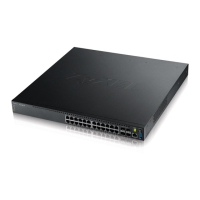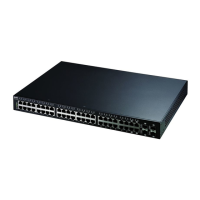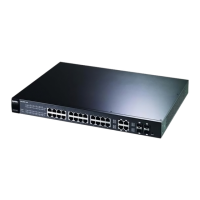Chapter 11 Spanning Tree Protocol
GS3700/XGS3700 Series User’s Guide
144
The following table describes the labels in this screen.
Table 60 Advanced Application > Spanning Tree Protocol > MRSTP
LABEL DESCRIPTION
Status Click Status to display the MRSTP Status screen (see
Figure 99 on page 145).
Tree This is a read only index number of the STP trees.
Active Select this check box to activate an STP tree. Clear this checkbox to disable an STP tree.
Note: You must also activate Multiple Rapid Spanning Tree in the Advanced Application
> Spanning Tree Protocol > Configuration screen to enable MRSTP on the Switch.
Bridge Priority Bridge priority is used in determining the root switch, root port and designated port. The
switch with the highest priority (lowest numeric value) becomes the STP root switch. If all
switches have the same priority, the switch with the lowest MAC address will then become
the root switch. Select a value from the drop-down list box.
The lower the numeric value you assign, the higher the priority for this bridge.
Bridge Priority determines the root bridge, which in turn determines Hello Time, Max Age
and Forwarding Delay.
Hello Time This is the time interval in seconds between BPDU (Bridge Protocol Data Units)
configuration message generations by the root switch. The allowed range is 1 to 10
seconds.
Max Age This is the maximum time (in seconds) a switch can wait without receiving a BPDU before
attempting to reconfigure. All switch ports (except for designated ports) should receive
BPDUs at regular intervals. Any port that ages out STP information (provided in the last
BPDU) becomes the designated port for the attached LAN. If it is a root port, a new root
port is selected from among the Switch ports attached to the network. The allowed range
is 6 to 40 seconds.
Forwarding Delay This is the maximum time (in seconds) a switch will wait before changing states. This
delay is required because every switch must receive information about topology changes
before it starts to forward frames. In addition, each port needs time to listen for
conflicting information that would make it return to a blocking state; otherwise,
temporary data loops might result. The allowed range is 4 to 30 seconds.
As a general rule:
Note: 2 * (Forward Delay - 1) >= Max Age >= 2 * (Hello Time + 1)
Slot (Stacking
mode)
This field appears only in stacking mode. Click the drop-down list to choose the slot
number of the Switch in a stack.
Port (Standalone
or stacking
mode)
This field displays the port number. In stacking mode, the first box field is the slot ID and
the second field is the port number.
* Settings in this row apply to all ports.
Use this row only if you want to make some settings the same for all ports. Use this row
first to set the common settings and then make adjustments on a port-by-port basis.
Note: Changes in this row are copied to all the ports as soon as you make them.
Active Select this check box to activate STP on this port.
Edge Select this check box to configure a port as an edge port when it is directly attached to a
computer. An edge port changes its initial STP port state from blocking state to forwarding
state immediately without going through listening and learning states right after the port
is configured as an edge port or when its link status changes.
Note: An edge port becomes a non-edge port as soon as it receives a Bridge Protocol Data
Unit (BPDU).

